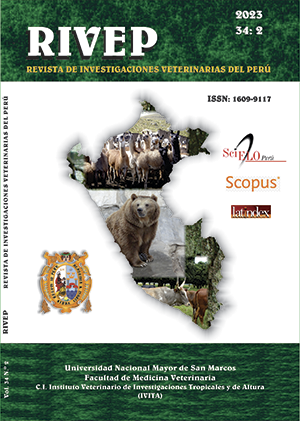Detection of microorganisms and characterization of histopathological lesions in cultivated and wild scallops (Argopecten purpuratus) in summer and winter
DOI:
https://doi.org/10.15381/rivep.v34i2.25104Keywords:
Argopecten purpuratus, Peruvian scallops, histopathology, intracellular microcolonies of bacteria, ICMAbstract
The aim of this study was to detect parasitic agents and describe histopathological lesions in scallops (Argopecten purpuratus) from Ancash, Peru, during the summer and winter periods. In total, 360 mollusks were collected, in equal parts from aquaculture farms and wildlife, and in the summer and winter seasons (90 per group). The samples were preserved in Davidson's solution and analyzed by histology. The Chi-square test was used to determine possible associations between the variables. The histopathological findings in digestive glands and gills were similar, finding intracellular microcolonies of bacteria (ICM), hemocyte infiltration and tissue necrosis in all study groups. The prevalence of MCI was associated with the season of the year. Nephridial concretions occurred in all groups. The mantle was mostly affected by the presence of trematodes and hemocyte infiltration, especially in summer. It is concluded that there are microorganisms that affect and cause tissue lesions in Peruvian scallops.
Downloads
Downloads
Published
Issue
Section
License
Copyright (c) 2023 Adhemir Valera A., Rosa Villegas, Alberto Manchego S., Luis LLanco A., Enrique Serrano-Martínez, Nieves Sandoval C.

This work is licensed under a Creative Commons Attribution 4.0 International License.
AUTHORS RETAIN THEIR RIGHTS:
a. Authors retain their trade mark rights and patent, and also on any process or procedure described in the article.
b. Authors retain their right to share, copy, distribute, perform and publicly communicate their article (eg, to place their article in an institutional repository or publish it in a book), with an acknowledgment of its initial publication in the Revista de Investigaciones Veterinarias del Perú (RIVEP).
c. Authors retain theirs right to make a subsequent publication of their work, to use the article or any part thereof (eg a compilation of his papers, lecture notes, thesis, or a book), always indicating the source of publication (the originator of the work, journal, volume, number and date).



